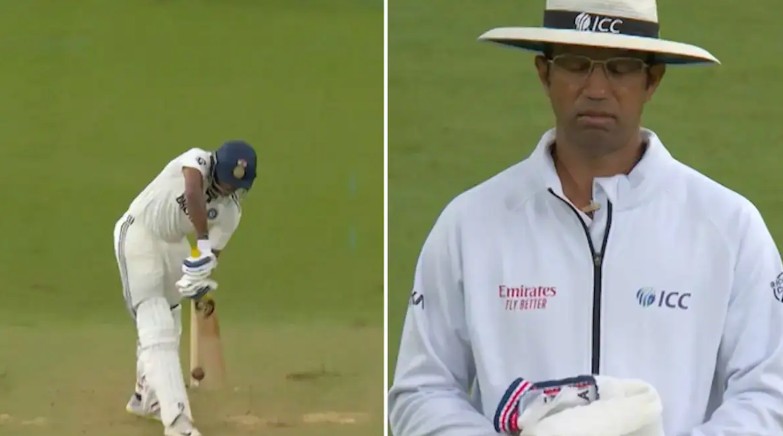August 1, 2025 — A storm of controversy erupted on Day 1 of the fifth and final Test between India and England at The Oval, when veteran Sri Lankan umpire Kumar Dharmasena appeared to unintentionally help England save a DRS review. The incident, though brief in the moment, has triggered wide criticism and rekindled debates around umpiring protocol in the DRS era.
The Incident: A Gesture That Sparked Fury
The moment of contention arose during England pacer Josh Tongue’s appeal for an LBW against Indian batter B Sai Sudharsan. Dharmasena turned down the appeal but went a step further — instinctively gesturing that there was an inside edge involved. The problem? Such gestures are explicitly discouraged under current umpiring guidelines in the DRS era.
England, seemingly influenced by the umpire’s unintended cue, chose not to review the decision. Had they gone for the review, a potential overturn might have followed — or, at the very least, they would have lost a review on their own terms, not due to unofficial input from the umpire.
Why It’s Controversial?
Under the Decision Review System (DRS) protocols, umpires are required to maintain neutrality post-decision. Once an on-field appeal is declined, players have 15 seconds to decide whether to opt for a review. During this window, any form of body language or hint from the umpire — especially one that indicates the possible rationale for the decision — is considered a breach of conduct.
Critics argue that Dharmasena’s gesture, although likely unintentional, compromised the fairness of the review process by indirectly influencing England’s decision-making.
Sanjay Bangar: Old Habits Die Hard
Former India cricketer and coach Sanjay Bangar weighed in on the controversy, suggesting that the gesture may be a product of Dharmasena’s early umpiring days, prior to the adoption of DRS.
“These habits don’t go away easily for umpires because it’s second nature to them,” Bangar told broadcasters. “When Dharmasena had started his umpiring career, there was no DRS then. Now, you’re not supposed to give a signal on what’s going on in your mind. The umpire should not have done that.”
Bangar’s comments highlight a broader issue — the challenge veteran umpires face in adapting to the newer review-based system, where every subtle signal carries weight.
Anil Chaudhary Defends Dharmasena: A Mistake, Not Malice
Indian umpire Anil Chaudhary also responded to the uproar, offering a more sympathetic perspective.
“It just happens by mistake. No umpire at that level will do it deliberately. It also sometimes happens with us in domestic matches, as it happens in a flow. But you have to be very careful, especially in the 15-second window with the DRS.”
Chaudhary’s statement underlines the thin line between instinct and error — and the high scrutiny umpires face in the international arena.
Public Reaction and the “Aadatein Jaati Nahi” Outcry
The phrase “Aadatein Jaati Nahi” (habits don’t go away) quickly began trending on social media, as fans and analysts vented frustration over the lapse. While some demanded stricter penalties or re-training for umpires, others called for clearer enforcement of DRS protocols.
A Pattern of Controversy?
This isn’t the first time Dharmasena has been under the spotlight for a contentious decision. He was one of the umpires during the infamous 2019 World Cup final between England and New Zealand — another match marred by rule ambiguities and umpiring judgment calls.
Looking Ahead: Time for Reforms?
The incident reignites discussions about whether umpires — especially those who began their careers before the DRS era — need refreshed training to align with evolving rules and expectations.
While no formal reprimand has been issued yet, the ICC may come under pressure to clarify or tighten umpiring standards in the wake of the latest incident.
In elite cricket, where the margins are razor-thin, even a flick of the fingers can tilt the scales. Whether Dharmasena’s gesture was an honest mistake or a remnant of an outdated habit, the controversy serves as a sharp reminder: in the DRS age, neutrality isn’t just about the decision — it’s about the perception of it too.



